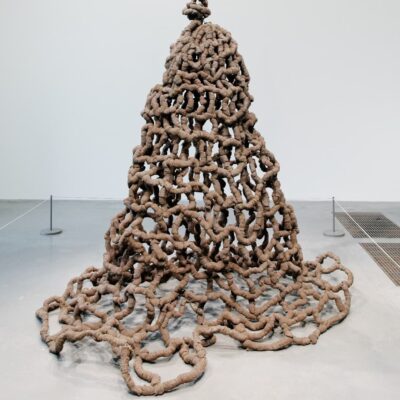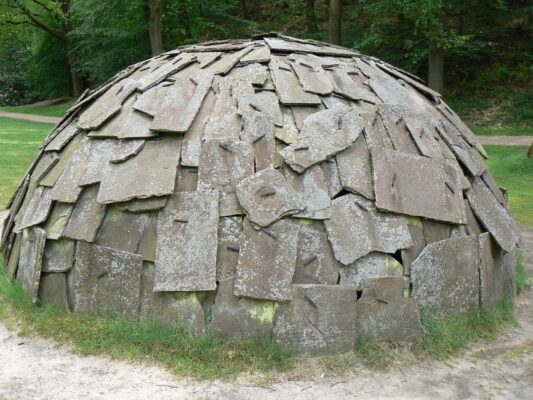Arte Povera
Sacos, troncos y tierra: anti-industrialismo en el Museo
La banalidad ha entrado en el terreno del arte. Aparece lo que es insignificante, o más bien está empezando a imponerse. El comportamiento y la presencia física se han convertido en arte.
Germano Celant, exposición “Arte povera – Im Spazio”, 1967
Pino Pascali: “Trapola”, 1968. Londres, Tate Modern. Fotografía de Marie-Lan Nguyen, licencia CC-BY 2.5 ·· Mario Merz: “Igloo di pietra”, 1982 KMM sculpturepark, Países Bajos.
Tras el fin de la Segunda Guerra Mundial, y gracias en parte a la inyección económica procedente del Plan Marshall, Italia atravesó un periodo de crecimiento económico conocido como Milagro económico italiano, que duraría hasta comienzos de la década de los 70. La industria italiana, enormemente dañada durante la Guerra, florece de nuevo. Los FIAT 500 y 600 son producidos y adquiridos por miles, y Olivetti llena los hogares y oficina con calculadoras y máquinas de escribir, hasta llegar a convertirse en proto-computadores como el Programma 101. Esto provoca una emigración del rural a las zonas de producción industrial, localizadas en la mitad norte del país, lo que a su vez causa un boom constructivo en estas áreas. Podría decirse que, en la Italia de los años 60, las más radicales utopías Futuristas sobre el triunfo de la sociedad industrial estaban cerca de cumplirse.
En este contexto, el Arte Povera (Arte Pobre) surge como una crítica a la industrialización y a la omnipresente tecnología, y –en menor medida- como una reacción frente al Minimalismo, entonces en su apogeo. Aboga por el uso de materiales humildes (pobres), olvidados por la moderna industria, desde tierra y madera hasta sacos y cuerdas, que se degradan y transforman con el paso del tiempo; a la vez que busca recuperar el método de trabajo artesanal. El Arte Povera “entona una elegía por un mundo en desaparición, investigado con interés de arqueólogo” (Museo Reina Sofía, “Espacios de vida: las políticas del arte povera”). En este sentido, resulta tentador vincular (al menos filosóficamente) el origen del Arte Povera con el del Romanticismo del siglo XIX, que también abogó por una recuperación del pasado frente a una Revolución Industrial todavía en su apogeo. No obstante, puestos a buscar antecedentes, el caso más claro es el de la Pintura matérica de los años 50, representada por artistas como Alberto Burri y Antoni Tàpies, quienes también emplearon materiales “povera” (tierra, sacos) en sus obras, en las que el intervinieron –hasta el punto de destruirlas parcialmente- mediante quemaduras o cortes.
La presentación pública del Arte Povera tuvo lugar en la exposición “Arte povera – Im Spazio” de 1967, comisariada por el crítico Germano Celant (1940-2020). En la primera sección de la exposición, dedicada al Arte Povera, expusieron, entre otros, Alighiero Boetti (1940-1994), Luciano Fabro (1936-2007) y Jannis Kounellis (1936-2017). Ese mismo año, Michelangelo Pistoletto (n.1933) presenta su “Venere degli stracci” (Venus de los trapos), cuya popularidad ayudó a la difusión del Arte Povera por toda Italia.
Aunque el Arte Povera fue un movimiento eminentemente italiano, tuvo, en especial durante la década de los 70, una gran aceptación en los Estados Unidos. Este éxito es atribuible en especial a dos figuras. La primera de ellas es el ya mencionado Germano Celant, quien publicó en varios idiomas, incluyendo el inglés, el manifiesto “Arte Povera: Appunti per una guerriglia” (Arte Povera: apuntes para una guerrilla), que hábilmente identificaba el movimiento con la revolución y el radicalismo, en una época en la que la Guerra de Vietnam y las protestas de 1968 habían proporcionado un caldo de cultivo ideal para estas ideas. En este sentido, «La guerra de guerrillas metafórica de Celant también fue apropiada por los estudiantes universitarios disidentes, que se identificaron con héroes políticos como Fidel Castro, el presidente Mao, Ho Chi Minh y el Che Guevara y adoptaron las tácticas de guerrilla del general Nguyen Giap, prediciendo: «La universidad será nuestro Vietnam»«. (Nicholas Cullinan: «From Vietnam to Fiat-nam: The Politics of Arte Povera», 2008). La segunda gran figura fue la galerista Ileana Sonnabend (1914-2007), que expuso las obras de los artistas del Arte Povera en su galería del Soho neoyorquino, inaugurada en 1971, dando hogar y promoción a los “guerrilleros” de Celant.
G. Fernández · theartwolf.com
Follow us on:


